
The Homer Spit is the end of the road. © Michael Halstead. Right: Dragging this big ‘but up to weigh-in. © Hastings A. Franks.
by Troy Letherman
In this part of Alaska, heading south by road will eventually take you to only one place. After the scenic bend around Turnagain Arm, after tracing miles of the turquoise upper Kenai, after passing through Sterling and Soldotna and roadside meadows resplendent with patches of blooming fireweed and wild geraniums, lupine and Jacob’s ladder, with Mounts Iliamna, Redoubt and Spurr defining the Cook Inlet horizon, the highway rounds one final corner and drops into the city of Homer—literally the end of the road.
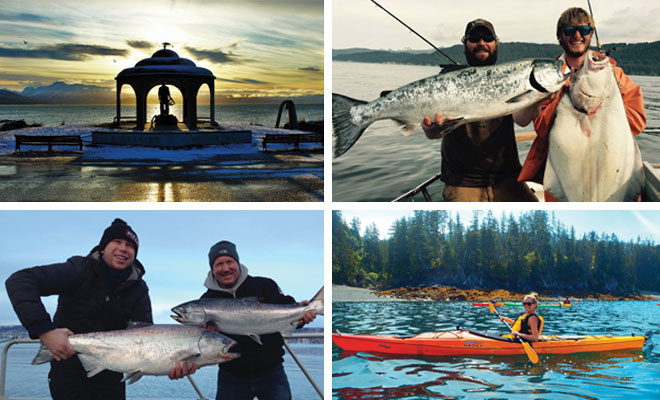
Top Left, Clockwise: Homer’s seafarer memorial. © Russell Campbell. A couple of good-sized fish for a combo. © Homer Ocean Charters. Kayaking in the bay is a popular sport; you can rent kayaks from Homer Ocean Charters. © Homer Ocean Charters. A pair of chrome winter kings caught in January with Captain Steve Tutt. © Homer Winter King Fishing.
Nestled among rolling hills overlooking Kachemak Bay, the seaside community of Homer offers a breathtaking view of the surrounding mountains, glaciers and bay, as well as serving as the gateway to a world of outdoor adventure. Often described as the Halibut Fishing Capital of the World, Homer is a captivating little town with something to offer for everyone—from families to diehard outdoors enthusiasts alike. It might be the last place a road-bound angler can end up, but it should be the first place we think of when planning our next trip.
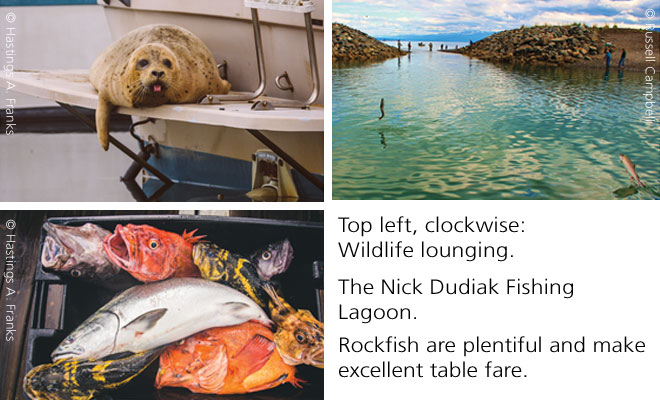
Drawn to its abundant, diverse land and marine animals and relatively mild climate, people have inhabited Kachemak Bay for thousands of years. In the 1800s, homesteaders and coal miners made up the area’s population and Homer became a booming company town until the demand for coal diminished in the early 1900s. Some years later, the commercial harvest and processing of fish became the mainstay of the local economy and led the growth of Homer into the commercial and transportation hub of the southern Kenai Peninsula. Today, Homer’s economy relies on commercial fishing and a growing tourism industry.
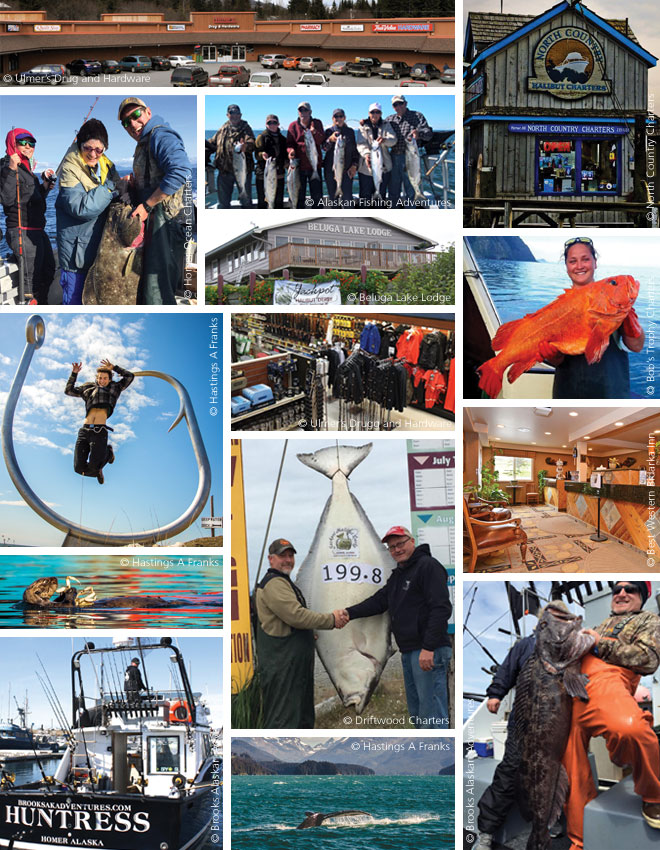
Scenes from around Homer; incredible vistas, prolific wildlife, amazing saltwater fishing, jackpot derbies, plus great places to stay and shop. There’s lots of fun to be had on a trip to Homer.
Homer is located at the southern tip of the Kenai Peninsula, Alaska’s playground. It can be reached from Anchorage by a 4 ½-hour scenic drive or a short 30-minute flight. With the breadth of activities offered, the sights to see and excursions to enjoy, plan to stay at least a week to fully experience Homer.
Some of the most popular activities are hiking, fishing and bear-viewing, but don’t miss out on sea kayaking, paddle-boarding, bird-watching, cycling, kite surfing and whale-watching. And for those down-days recuperating, there is shopping, a winery, brewery, art galleries and museums. The outdoor activities may be plentiful, but Homer also has renowned restaurants and is known as a “foodie” town. You can shop at an outdoor Farmers’ Market, dine at organic bakeries and lunch spots, enjoy fresh seafood and sushi and sample the range of local cuisine. There is no other small town in Alaska with the number of top restaurants open year-round. In the evening, relax at one of the many B&Bs, hotels and log cabins open all year.
While in or around Homer you could see moose grazing, a black bear crossing the road, puffins, seabirds, soaring eagles, sea otters, porpoises, killer whales, porcupine, harbor seals, beluga whales and more. A simple drive on any of Homer’s back roads or a morning boat tour on the bay will make wildlife viewing easy and enjoyable.
For the real adventurous members of your group, Homer has several air charters that will fly you over the Harding Ice Field and Pacific Ring of Fire volcanoes, or drop you off at a wilderness cabin on a secluded lake where you can fish for trout, char and other species. Another highlight is a chance to kayak in the pristine coves along Kachemak Bay. Experience the diverse landscape of fjords, forest, islands, lagoons, jagged mountains and unspoiled wild coastline. Or take a water-taxi from the Homer Spit across the bay to Grewingk Lake Trailhead and then hike to a glacier lake or take your stand-up paddle-board out among icebergs. Homer also offers guided fly-out bear viewing trips to Katmai National Park from June through late September for up-close-and-personal time with Alaska’s famous bruins.
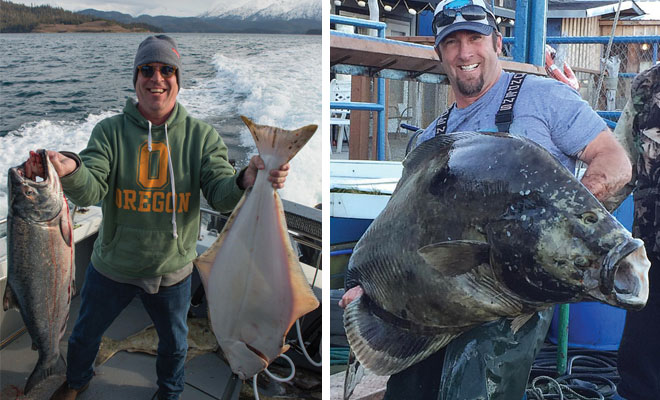
Left: Combo trips for halibut and salmon offer a prime chance to put fresh fish on the table. Right: If it is trophy halibut you are after then a full-day trip in late August is the best time to book. Plan for big kings earler in the season. You don’t want to wait to reserve days as they book fast. © O’FIsh’ial Charters.
Across the bay, Kachemak Bay State Park offers over 30 miles of trail and 375,000 acres of wilderness, provides excellent backcountry hiking, camping, wildlife viewing, lake- and stream fishing, and cabin rentals. Visit scenic Halibut Cove, a remote fishing and artist’s village where the streets are paved with water. And don’t miss Seldovia, where berry-picking, hiking, kayaking and mountain biking are just a few of the activities in the town known as “The City of Secluded Charm.”
Fishing, however, is truly the highlight of this bountiful region, and Homer is known across the planet for its world-class halibut and salmon fishing. Saltwater anglers can fish at the Fishing Lagoon right on the Homer Spit, a long, narrow finger of land jutting four and a half miles into Kachemak Bay, or they can choose from a large variety of half-day, full-day and extended fishing charters, all of which begin at the Homer small-boat harbor on the Spit.
The harbor is home to over 700 year-round charter and commercial-boat operators—a number that grows to over 1,500 in the summer months. With everything to see and do in and around Homer, and with the amount of infrastructure available for boaters, Homer serves as an excellent port of call and a growing number of Alaskans are choosing to store their boats here year-round, having quick access to the thriving fisheries of Kachemak Bay and Cook Inlet.
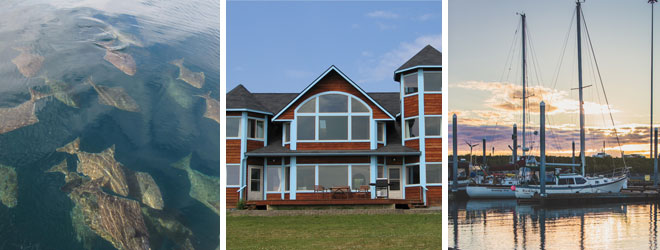
Left to Right: Halibut on the surface. © North Country Charters. Driftwood Inn’s modern Seaside Lodge. © Driftwood Inn. Homer is a great place to make your port. © Hastings A. Franks.
Anglers enjoying the marine environment out of Homer can do well for salmon and sea-run Dolly Varden by fishing in or near the stream mouths just about anywhere in the bay. These clear-green waters are home to both natural and enhanced runs of salmon, as well as a rich assemblage of shellfish and bottomfish. Halibut, rockfish and lingcod anglers can target the shoals and reefs found in deeper water. Similarly, the majority of Chinook anglers target mature, stream-bound kings in the outer bay from about mid-May through early June, while trollers in search of the smaller, ‘feeder’ kings can have productive days year-round (every March, there is a winter king salmon derby held in Homer that attracts anglers from around the state).
However, in Homer, halibut is king, and one of the largest charter fleets in Alaska operates out of the port bound for more remote areas of the bay and lower Cook Inlet. Kachemak Bay is ideal for small craft as well as larger sport-fishing vessels, and it’s typically only a short run from the boat-launch facilities at Homer Harbor to the south side, where the majority of the good angling takes place. Some of our favorites include Bob’s Trophy Charters, North Country Charters, Homer Ocean Charters, Brooks Alaskan Adventures, Homer King Fishing, Driftwood Charters and O’Fish’ial Charters. All of the above will put you on nice fish—and in Homer, much of the allure comes from the variety on offer. From year-round king fishing, which peaks in June and July, to silvers, lingcod and rockfish and the ever-present halibut, it’s more than worth a few days of any excursion to dock at the end of the road.
Halibut
Aptly named “The Halibut Capital of the World,” Homer has no shortage of tasty flatfish, and here, catching a limit is the norm, not the exception. The halibut near Homer tend to be smaller in the spring but increase in size as the season goes on. The peak of the season takes place in July and August, but there’s good fishing to be had all the way to the end of September.
Charters out of Homer have lots of options when it comes to fishing spots. If you are pressed for time you can catch a shorter-range half-day boat. There are also three-quarter-day trips that push out a bit farther. If you want the best chance at a fish over 100 pounds, try a full-day excursion. On those trips, you’ll run 25- to sometimes 60 miles from town to hit the waters that the local boats don’t fish as often. The area also has plenty of protected water and islands for when the weather kicks up so there’s almost always a place to fish that’s not too rough.
Though halibut are usually not in short supply in Kachemak Bay, there are a few areas that are more productive than others. The “Compass Rose” is one of Homer’s most notorious halibut holes, and you could find there one of the Homer Jackpot Halibut Derby’s tagged fish. Though the Derby’s tagged fish are worth varying amounts, at least one is worth $50,000 (in 2016). To qualify for derby winnings, anglers must first purchase a $10 per-day Homer Jackpot Halibut Derby ticket. Derby tickets are available at most tackle and charter businesses on the Spit and throughout Homer. If looking for an alternative, many anglers find success fishing the Bluffs (from Bluff Point to Anchor Point), the Seldovia Bump (150- to 250 feet of water in front of Seldovia Bay) and Up-the-Bay (the waters east of the Homer Spit).
Per statewide regulations, charters are not allowed to fish on Wednesdays and the annual bag limit fishing with a charter is four fish. There is a two-fish daily limit on halibut in this region, allowing anglers to keep one fish of any size and one 28 inches or smaller.
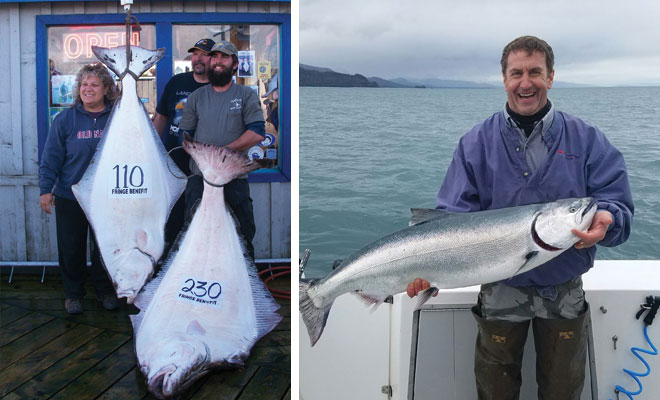
Left to Right: They are catching some nice halibut in Homer. © North Country Charters. Chromers like this are the tastiest. © Bob’s Trophy Charters
King Salmon
The area from Gore Point south of Homer across to Bluff Point and on up to Ninilchik offers some spectacular opportunity to hook, land and eat some of the world’s best king salmon. The fishery here may seem a little odd to diehard saltwater king anglers as you are often trolling in less than 20 feet of water and within a stone’s throw of the beach. Anglers use just enough lead to almost scrape the bottom with their banana weight/dodger/herring rig and adjust as needed as the tide ebbs and flows.
The fishery targets a mixture of Chinook stocks bound for local rivers and streams and is also supplemented by an intermingling of immature “feeder” kings that come from as far away as Oregon. Early-run fish are available before and up to about the third week of June 25, with late-run kings entering the area waters after that. Feeder kings are available year-round. The overall sport season (aside from the winter king season) runs from April into August with peaks and valleys in catch rates throughout season.
The “Central Cook Inlet” area is where perhaps the largest king salmon are caught, because it the superhighway for the fish to ride the tides up to the Ninilchik, Deep Creek, Kasilof, the mighty Kenai and other systems farther north. The vast majority of mature fish are caught well within a mile of shore while the feeders tend to be caught farther offshore and can be targeted there when the migrating fish aren’t cooperating.
This area consists of a 30-mile stretch of beach between Bluff Point and Deep Creek. Here, angler effort and success are greatly dictated by weather conditions. Farther south is the “Lower Cook Inlet” fishery, which is defined as south of Bluff Point and includes Kachemak Bay. Anglers have fished the area for saltwater Chinook for many years and there are reports of off-season “feeder” kings being caught here since the 1960s or earlier. ADF&G began supplementing the area’s fishery in 1979 with the inception of the Halibut Cove Lagoon salmon stocking program. Later, ADF&G augmented the program with the Nick Dudiak Fishing Lagoon (on the Homer Spit) in 1984 and in Seldovia in 1987. These projects have greatly increased opportunity in the area. The stocked fisheries are managed with the expectation that all returning fish are harvested and they are intended to provide an additional 25,000 sport angler/days of fishing opportunity. They are all “early-run” fisheries with fish returning between early May and mid-July, peaking near mid-June.
If not utilizing a charter service for your king salmon fishing, be sure to study the current regulation booklet before venturing out in Cook Inlet or the bay, as the daily and annual limits change across an invisible line at Bluff Point. There are also three “Conservation Zones” closed to fishing near Deep Creek, Stariski Creek and the Anchor River. Anglers likewise need to remain abreast of changes via Emergency Orders set by ADF&G, which can be found on the internet or via the department’s hotline.
Fishing for other species, including prized lingcod and plentiful rockfish, generally occurs in specific waters during trips for primary targets suchas kings or halibut. In the autumn, beginning in late July and August, silver salmon also enter the area, heading for their natal streams along the Kenai Peninsula coast, and the action can be fast and frenetic, both in Kachemak Bay and within the inlet. But whether your next adventure is purely based around enjoying some of Alaska’s fine fishing or you are looking to mix-in some kayaking, bear or marine-wildlife viewing, shopping, dining and sightseeing, Homer has it all. Variety is the spice of life, they say, and that’s even more relevant when it comes to planning the perfect all-around Alaska adventure. That’s why Homer is the place to start.
Troy Letherman was editor of Fish Alaska and Hunt Alaska magazine.
Visit Homer: Halibut Capital of the World originally appeared in the March 2017 issue of Fish Alaska.
Back to Destination Page
Back to Area Businesses
